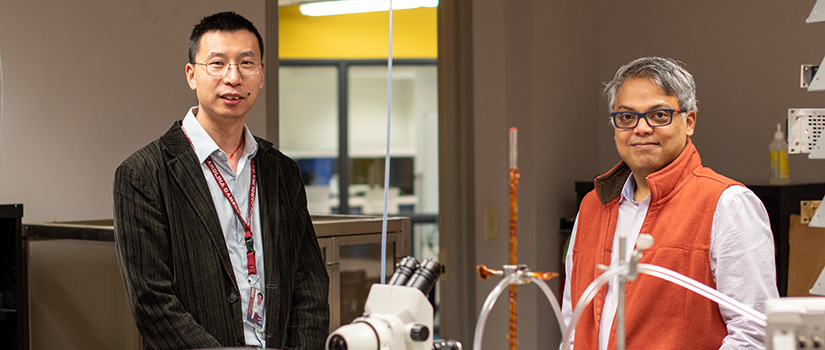NSF-funded research will use plasma-based technology to eliminate wasteful burning of oil by-products
By Abe Danaher | October 19, 2020
Natural gas is constantly being produced at chemical plants and oil refineries across the nation as a byproduct of creating plastics and fuel. As has always been the case, this gas is then burned in large flare stacks – ridding the companies of their waste by filling the air with a constant stream of pollutants and carbon dioxide.
Through a $2 million Emerging Frontiers in Research and Innovation (EFRI) grant from the National Science Foundation (NSF), the University of South Carolina, Stanford University and Princeton University are collaborating to create a cost-effective distributed chemical process that will allow for natural gas to be converted into useful chemicals and liquid fuels, instead of burned as harmful waste.
“Instead of flaring the natural gas out, if we can convert it to some useful product then it will not just limit greenhouse gas emissions, but then we can also use it as a fuel of some sort,” explains Tanvir Farouk, an associate professor of mechanical engineering at South Carolina. “The simplest example would be if you convert the natural gas to some alcohol, say ethanol or another higher chain alcohol, then you can use it for transportation or any other kind of fuel, if you like. It could even be used as chemical feedstock.”
The research will work in stages, starting at South Carolina. Led by Farouk and Lang Yuan, both co-principal investigators on the project, South Carolina’s team will develop novel, nonthermal plasma techniques and revolutionary 3D printing manufacturing techniques that will focus on the cost-effectiveness and scalability of the larger chemical process.
In the past, similar research was conducted using thermal plasma to try and eliminate natural gas waste. But, thermal processing has a low efficiency and is very expensive, as it requires heating the system to extreme temperatures, such as ~1500 degrees kelvin. The non-thermal process, called “misty plasma catalysis,” proposed by Farouk and the group will allow plasma to be kept at room temperature, and will enable electrical systems to power the process. With the cost of electrical power going down in recent years and with renewable energy’s increasing contributions to the electric power grid, the proposed process will be beneficial both economically and environmentally.
“We’ll have the plasma, but we will also have an aerosol of water coming in. First, this will lower the plasma’s temperature because you will have to vaporize the water, but then you can make these water particles react with the natural gas and, if you create alcohols, they can also absorb,” Farouk says. “So, from that perspective you are shooting two birds with one stone. It is suppressing the thermal effect and then this is also helping you in terms of the chemical re-forming process.”
Yuan will focus on the design and manufacturing of the chemical reactor housing the plasma, and how to maximize its efficiency while still allowing it to be produced at an industrial scale. Using advanced 3D-printing techniques, he will work to create unique hierarchical porous structures in the solid reactors – which will increase their reaction efficiency and maintain the stability of the process
“The extremely high surface to volume ratio will help to maximize the catalytic conversion rate,” says Yuan, an associate professor of mechanical engineering. The techniques will also allow for highly customized designs of manufactured parts.
South Carolina’s team will work with Michele Sarazen, an assistant professor at Princeton who specializes in catalysts and is the principal investigator on the project, and with Stanford Professor Xiaolin Zheng for her expertise on materials design. Professor Yiguang Ju at Princeton will also use his expertise in laser-based diagnostics to characterize the effectiveness of these novel plasmas and the overall system.
Together, the team hopes to create a process that can be used by supporting industry partners such as Exxon Mobile and BASF to eliminate their harmful waste and instead convert natural gas into a useful chemical product.
The Emerging Frontiers in Research and Innovation program was created in 2015 by the National Science Foundation. The goal of the program is to provide “critical, strategic support of fundamental discovery at the frontiers of engineering research and education.” The two topics selected for the program’s 2020 awards are distributed chemical manufacturing and engineering the elimination of end-of-life plastics.
